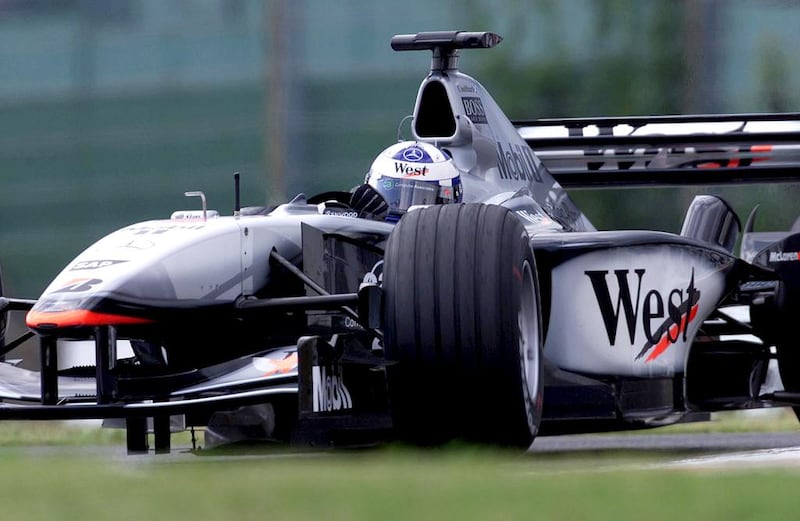Decades ago, Formula One cars were resplendent in colours representing the country of either the manufacturer or driver.
But in the 1960s commercial considerations started to take precedent over patriotic concerns and that remains the case today. Millions of dollars worth of sponsorship logos will be on display at the Abu Dhabi Grand Prix today.
Absent from the liveries at the Yas Marina Circuit, where Kimi Räikkönen of the Lotus Renault team tasted victory last year, will be any branding belonging to cigarette manufacturers. F1 was once synonymous with the tobacco industry but changing rules, regulations and attitudes have led to a gradual separation of the ways.
As recently as 2002 the amount of money invested in the sport each year by tobacco companies was estimated at the US$250 million. A report that year by the BMJ Group claimed Ferrari received $88m from Marlboro’s parent company Philip Morris, while the German cigarette brand West sponsored McLaren to the tune of $37m and British American Tobacco contributed $46m to British American Racing.
In 2005 a European Union (EU) ban on tobacco firms using branded goods to advertise was passed, effectively sounding the death knell for the cigarette industry’s decade’s old association with F1.
Certain countries, including the United Kingdom, already had a similar law in place but the EU legislation had serious repercussions – more than half of the Grand Prix venues used that year were in cities obliged by the law to adhere to the new regulations.
Formula One as a company is set to be floated on the Singapore Stock Market by the private equity firm CVC Capital Partners this year with the target valuation reportedly about the $10 billion mark. It is clear the group of companies responsible for the promotion of the FIA Formula One World Championship has not only survived in the post-tobacco sponsorship era, it has thrived.
While the loss of tobacco sponsorship left a void in the extravagant budget enjoyed by F1 teams it also created new opportunities, according to Nick Fry, the former chief executive of the Mercedes AMG Petronas Formula One team.
“While tobacco companies were generous partners of Formula One for nearly four decades the reality is that a large number of companies did not want to be associated with a team with tobacco logos on the car and indeed some didn’t want to be associated with the sport, which was very tobacco oriented. This [the ban on tobacco advertising] really has opened up a whole new door,” he said in 2007.
However, Marlboro did decide to renew its sponsorship of Ferrari in 2011 with a four-year deal worth an estimated $100m, despite knowing the brand’s logo would not be allowed to appear anywhere on the cars, drivers or track signage.
Marlboro remains the biggest-spending single F1 sponsor but according to a recent Formula Money report, the tobacco industry accounts for only 1 per cent of F1 sponsorship this year.
The biggest single segment of F1 support at present comes from telecommunciations companies, which contribute 19 per cent of sponsorship income. However, that figure will be dramatically reduced when Vodafone’s $75m per year sponsorship deal with McLaren expires at the end of this season.
Unsurprisingly, the automotive industry accounts for 18 per cent of F1 sponsorship, narrowly ahead of the fashion industry, which contributes 17 per cent. The latter figure was bolstered by Rolex’s decade-long deal to become the global partner and official time piece of the Grand Prix season, which is reportedly worth $35m per year.
From a financial perspective Formula One has been a remarkable success story, with the annual revenue of the F1 Group effectively doubling to $1.52bn in 2011 from $729m in 2003. It is clear the end of visible tobacco sponsorship has failed to dent the economic growth of the sport.
The reluctance of certain companies to get involved in F1 while the association with tobacco was so strong could be a factor but sponsorship is not the most significant stream behind the record revenues recorded in recent years.
Television income accounts for an estimated $500m, a third of overall revenue, while the site fees promoters must pay to host a race contribute approximately the same figure. Meanwhile, trackside advertising and corporate hospitality is estimated to bring in $300m a year.
F1 attracted a total global viewing audience of 500 million people during the 2012 season, making it one of the most-watched sporting events in the world.
Sebastian Vettel of the Red Bull Racing Team, already crowned this year’s champion taking his fourth title in a row, is the favourite to finish first at the Yas Marina Circuit today.
But regardless of which driver takes the chequered flag, the multibillion-dollar industry that is Formula One looks set to continue to enjoy precipitous financial growth.
business@thenational.ae





